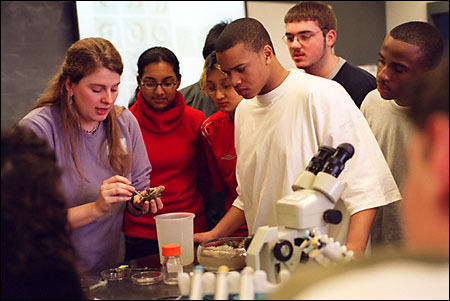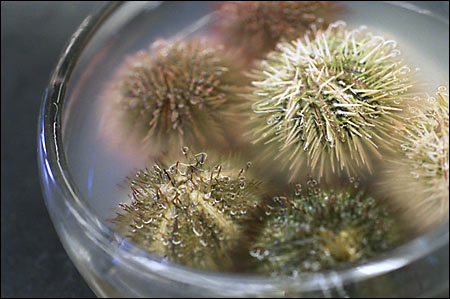MCB’s sessions get students hopping
A sea urchin – and maybe a scientist – is born

Put 18 or 20 high school seniors in a science lab, and you can expect a little saunter, a little swagger, a lot of wisecracking. But you hope for the best. Are they excited to be at Harvard?
“Oh yeah, I’m excited,” one deadpans, sinking into the lab bench. “Can’t you see the tears running down my cheeks?”
Jacqueline Brooks, a postdoc research associate in the Department of Molecular and Cellular Biology (MCB), doesn’t seem to notice the too-cool attitude that drifted in with the baggies and low-rise jeans. “They look enthusiastic!” she says perkily.
Maybe it’s a self-fulfilling prophecy, or maybe it’s Brooks’ topic of the day – sea urchin reproduction – but it isn’t long before the kids are crowding around her and her spiny specimens, straining over one another to get a good look.
“Those are alive?” one student asks.
“Will they bite us?” worries another.
“Oh, that’s so sad!” cries a tall, thin girl as Brooks begins to cut into one of the slowly undulating creatures with a small scissors.
“It’s just like a sushi bar,” Brooks responds. “Someone’s doing this right now in Harvard Square to get at the uni” – that’s the sea-urchin gonads considered a delicacy by raw-fish aficionados. “Ewwww!!!” is the unanimous response. But they are hooked.

Making time
It’s a scene that’s repeated again and again during MCB’s High School Outreach sessions, offered three times a year to more than 700 students and 60 teachers from a few dozen high schools in Massachusetts, Maine, Rhode Island, and New Hampshire. Funded by the Howard Hughes Medical Institute and Harvard’s Department of Molecular and Cellular Biology, the three-hour labs offer students a peek into college life and a little encouragement to continue their studies in biology beyond the high school level. Just like young bio majors at Harvard, they get hands-on experience studying fruitfly learning and memory, photosynthesis, the neuroscience of C. elegans worms, and electric signals and the cardiac cycle. The sea urchin lab is a pilot for a planned week of marine biology beginning next year.
Today’s class, from Cambridge Rindge & Latin School, is one of about 100 that applied to attend the program this semester, and teacher Paul McGuinness is clearly thrilled to have been selected. “It’s the time,” he says. “That’s a big deficiency we have at school, not enough time to do experiments. Here, they have a block of time. Three hours is enough to run a lab and analyze it.”
During today’s lab, the students will learn how sea urchins reproduce, but Brooks will also sneak in a little human sex education. She’ll show them how seemingly innocuous acts can have a big impact on the environment, introduce them to scientific concepts such as controlled studies, and instruct them in the use of research equipment like pipettes, welled slides, and state-of-the-art microscopes. “We design the curricula with that in mind,” says Tara Bennett, the outreach coordinator. “We want to expose them to as many different concepts as possible in the few hours we have. We want to get them motivated about science.”
Today, at least, it seems Bennett will get her wish.
Giving birth
Having earlier injected the urchins with potassium chloride to relieve them of their gametes, Brooks hands out a bit of sperm to every pair of students and assigns a “mother hen” at each of the four lab benches to watch over the beakers full of eggs. Though in the wild, sea urchins reproduce by simply releasing their gametes into the ocean, the students help these along by mixing the two directly. Brows furrow in concentration as they try to focus their microscopes with a little help from Bennett, McGuinness, curriculum coordinator Susan Johnson, and lab assistants Jennifer Naven and Julia Claggett. The room is abuzz as students race back and forth among tables to compare notes, bicker over whether the water in their beakers should be cloudy or clear, and gather round one another’s microscopes in search of impending fertilization, all accompanied by a running reproduction-based soundtrack from Brooks. Then, victory.

“I’ve got babies!” shouts a student named Freddie, who as the 19th class member to file in this morning is working solo, with a little help from Brooks. “I’m the first! I have kids, yo! Do you have kids?”
Soon all the tables are celebrating their own bundles of sea-urchin joy. “I’m a father!” says Sam. “I had my first kid and he’s not even human!”
“Hot damn,” Joas adds.
“Congratulations,” McGuinness says, “pass out the cigars.”
“Yeah!” says Igor, who wants to work in wildlife management. “I see eggs, I see sperm, I see life!”
As sperm and unfertilized eggs begin dying off in the heat of the microscopes’ light or at the edges of the slides’ evaporating sea water, Brooks draws attention to a few stations set up in advance at the side of the room. Here they can see various stages of sea-urchin fertilization, as well as a few examples of planaria, a flatworm species used to study regeneration, wound healing, and stem cells. These 3-millimeter-long creatures generate almost as much commotion as the pending embryos did.
“It’s cross-eyed!”
“It has eyes?”
“Oh, and it’s moving!”
“Duh, it’s alive.”
“Dude!”
Sinister suds
After a short break during which cookies and soda are served in the hallway, Brooks returns to the blackboard to say a few words before beginning the next experiment. “Sea urchins are used as a model to test for environmental effects,” she points out, “because they’re very sensitive. They’re used to test for water quality. Today we’ll look at different environmental factors that can impinge on the fertilization process.” Each of the tables will study the effects of either UV exposure or varying pH levels – “we’ve all heard of acid rain, right?” – on their developing embryos. Brooks demonstrates the workings of a strand of DNA using one student’s jacket zipper, and hands out beakers containing diluted detergent.
“Only three parts per million of detergent can kill these embryos,” she says. “So if you go camping and wash your hair in the creek, that’s detergent. When you wash your car in the street, that water goes down the drain and eventually into the sea. People who wash their boats at the docks – or even if you jump into the water with your clothes on – that can mess it up.”
The results of this experiment, in scientific terms, are less successful than the earlier one, with some students achieving up to 90 percent fertilization despite the addition of detergent to their gametes. Still, Brooks maintains, the statistics don’t really matter. “These kids think science is cool,” she says. “They watch TV shows like ‘CSI.’ Some bring their digital cameras or their parents to these labs. At the beginning, there are always a couple of kids who are rolling their eyes, like I’m impinging on their social life. Those are the ones I want to get to. And by the end they’re always all smiles.”




